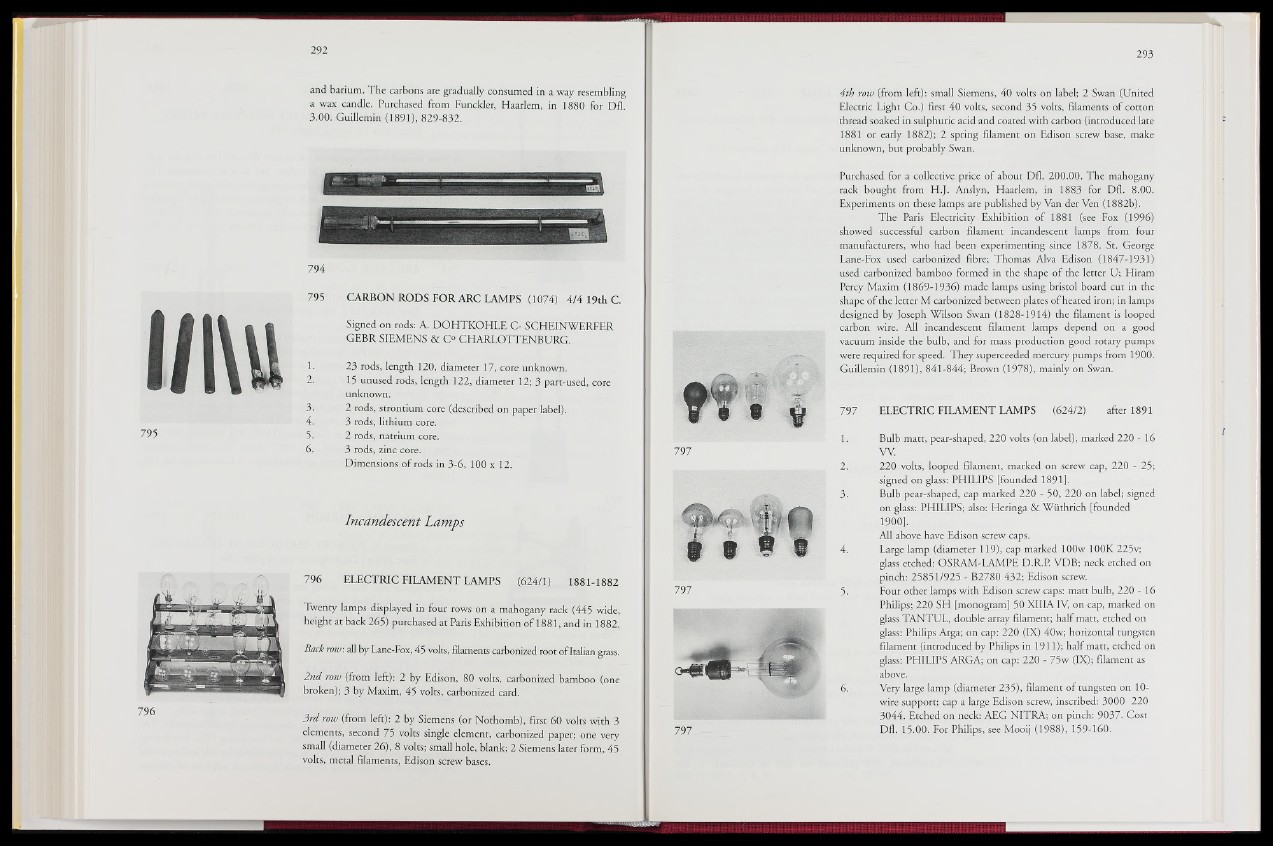
and barium. The carbons are gradually consumed in a way resembling
a wax candle. Purchased from Funcider, Haarlem, in 1880 for Dfl.
3.00. Guillemin (1891), 829-832.
794
795
795 CARBON RODS FOR ARC LAMPS (1074) 4/4 19th C.
Signed on rods: A. DOHTKOHLE C- SCHEINWERFER
GEBR SIEMENS & C° CHARLOTTENBURG.
1. 23 rods, length 120, diameter 17, core unknown.
2- 15 unused rods, length 122, diameter 12; 3 part-used, core
unknown.
3. 2 rods, strontium core (described on paper label).
4. 3 rods, lithium core.
5. 2 rods, natrium core.
6. 3 rods, zinc core.
Dimensions of rods in 3-6, 100 x 12.
Incandescent Lamps
796 ELECTRIC FILAMENT LAMPS (624/ii . 1881-1882
Twenty lamps displayed in four rows on a mahogany rack (445 wide,
height at back 265) purchased at Paris Exhibition of 1881, and in 1882.
Back row: all by Lane-Fox, 45 volts, filaments carbonized root of Italian grass.
2nd row (from left)::: 2 by Edison, 80 volts, carbonized bamboo (one
broken); 3 by Maxim, 45 volts, carbonized card.
3rd row (from left): 2 by Siemens (or Nofhomb), first 60 volts with 3
elements, second 75 volts single element, carbonized paper; one very
small (diameter 26), 8 volts; small hole, blank; 2 Siemens later form§||5
volts, metal filaments, Edison screw bases.
I j , i , I I i I I I 1 11 i ti i j 1 - I __________________ i j
797
W>7 '
7977
4th row (from left): small Siemens, 40 volts on label; 2 Swan (United
Electric Light Co.) first 40 volts, second 35 volts, filaments of cotton
thread soaked in sulphuric acid and coated with carbon (introduced late
1881 or early 1882); 2 spring filament on Edison screw base, make
unknown, but probably Swan.
Purchased for a collective price of about Dfl. 200.00. The mahogany
rack bought from H.J. Anslyn, Haarlem, in 1883 for Dfl. 8.00.
Experiments on these lamps are published by Van der Ven (1882b).
The Paris Electricity Exhibition of 1881 (see Fox (1996)
showed successful carbon filament incandescent lamps from four
manufacturers, who had been experimenting since 1878. St. George
Lane-Fox used carbonized fibre; Thomas Alva Edison (1847-1931)
used carbonized bamboo formed in the shape of the letter U; Hiram
Percy Maxim (1869-1936) made lamps using bristol board cut in the
shape of the letter M carbonized between plates of heated iron; in lamps
designed by Joseph Wilson Swan (1828-1914) the filament is looped
carbon wire. All incandescent filament lamps depend on a good
vacuum inside the bulb, and for mass production good rotary pumps
were required for speed. They superceeded mercury pumps from 1900.
Guillemin (1891), 841-844; Brown (1978), mainly on Swan.
797 ELECTRIC FILAMENT LAMPS (624/2) after 1891
1. Bulb matt, pear-shaped, 220 volts (on label), marked 220 - 16
W .
2. 220 volts, looped filament, marked on screw cap, 220 - 25;
signed on glass: PHILIPS [founded 1891].
3. Bulb pear-shaped, cap marked 220 - 50, 220 on label; signed
on glass: PHILIPS; also: Heringa & Wüthrich [founded
1900].
All above have Edison screw caps.
4. Large lamp (diameter 119), cap marked lOOw 100K 225v;
glass etched: OSRAM-LAMPE D.R.P. VDB; neck etched on
pinch: 25851/925 - B2780 432; Edison screw.
5. Four other lamps with Edison screw caps: matt bulb, 220 - 16
Philips; 220 SH [monogram] 50 XIIIAIV, on cap, marked on
glass TANTUL, double array filament; half matt, etched on
glass: Philips Arga; on cap: 220 (IX) 40w; horizontal tungsten
filament (introduced by Philips in 1911); half matt, etched on
glass: PHILIPS ARGA; on cap: 220 - 75w (IX); filament as
above.
6. Very large lamp (diameter 235), filament of tungsten on 10-
wire support; cap a large Edison screw, inscribed: 3000 220
3044. Etched on neck: AEG NITRA; on pinch: 9037. Cost
Dfl.i5.00. For Philips, see Mooij (1988), 159-160.
y i.Ev I [11 i i lITillll I flîTTrTlTTTI I ini ¡¡¡¡¡¡I